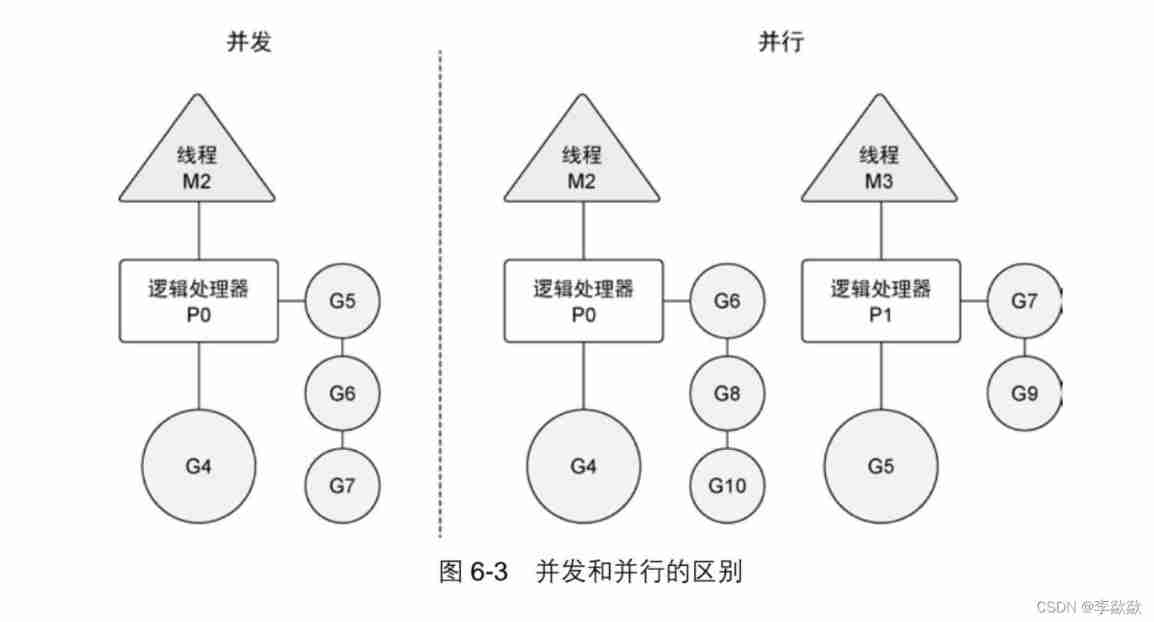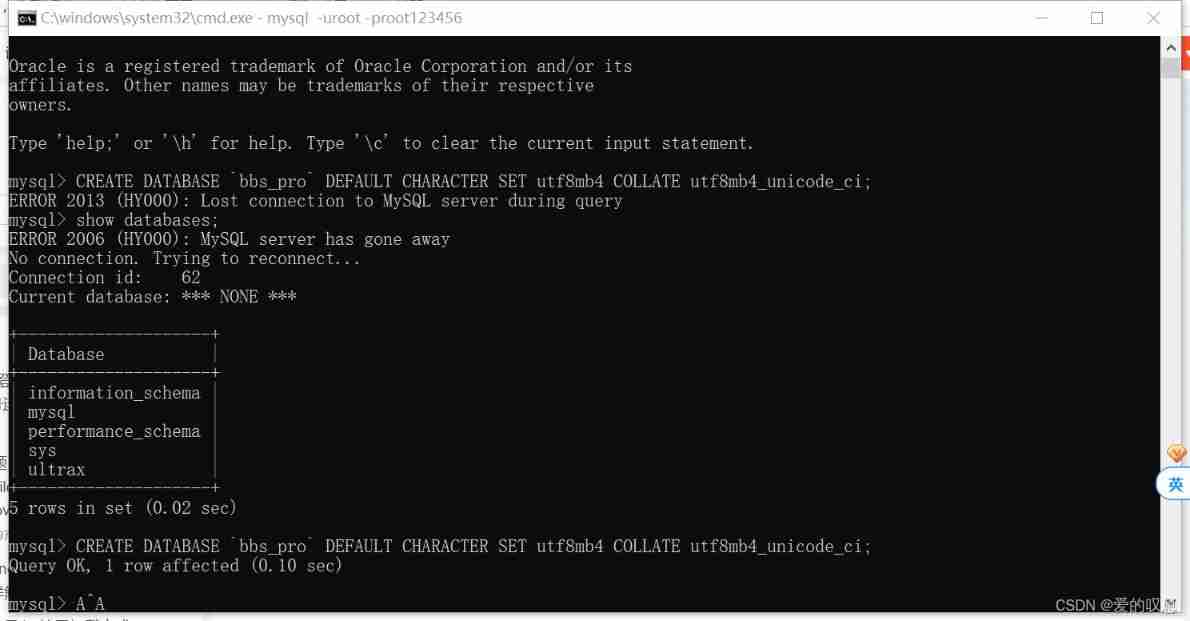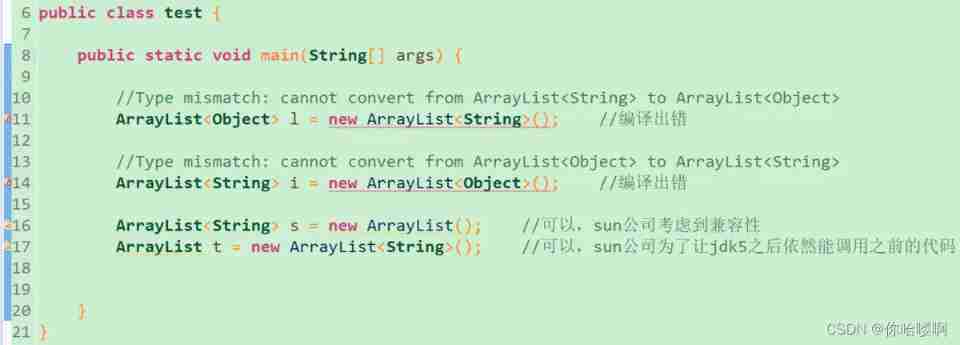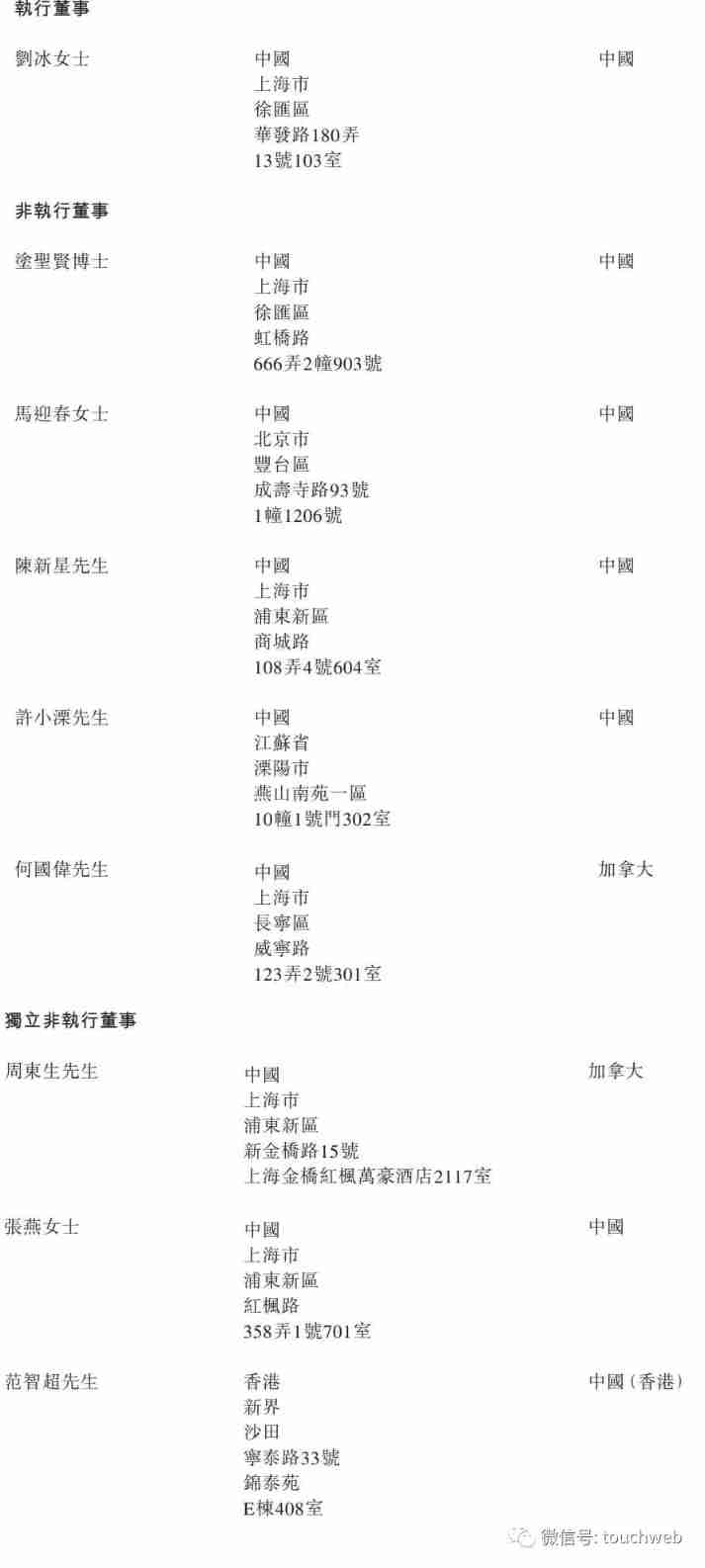当前位置:网站首页>What is the GPM scheduler for go?
What is the GPM scheduler for go?
2022-07-04 00:27:00 【Li Jue】

There are seven common concurrency models :
Threads and locks
Functional programming
Clojure Road
actor
Communication sequence process (CSP)
Data level parallelism
Lambda framework
Go Concurrent model of -CSP
Go The concurrent synchronization model of the language comes from a process called communication sequence (Communicating Sequential Processes,CSP) The paradigm of (paradigm), The core idea is to pass two concurrent entities through the channel channel Connect , All messages passed channel transmission ..CSP It's a messaging model , By means of goroutine Passing data between to pass messages , Instead of locking the data for synchronous access . Used in goroutine The key data types that synchronize and transfer data between are called channels (channel).
Go The scheduling model of -GPM
that CSP And Go What does language matter ? So let's see Go Language pairs CSP Implementation of concurrency model ——GPM Scheduling model .
GPM Scheduling model
GPM It represents three roles , Namely Goroutine、Processor、Machine.
Goroutine: It's what we usually use go Keyword created execution , It corresponds to a structure g, The structure is preserved goroutine Stack information for
Machine: Represents the thread of the operating system
Processor: Represents a processor , management G and M The connection of
Goroutine
Goroutine Is used in the code go Keyword created execution unit , We are also familiar with “ Lightweight threads ” It is called the synergy , Coroutines is Unknown to the operating system , It is implemented at the programming language level , Context switching does not need to go through kernel mode , In addition, the memory space occupied by the coroutine is very small , So it has great development potential .
go func() {}()
stay Go In language ,Goroutine By a person named runtime.go The structure of , This structure is very complex , Yes 40 Multiple member variables , It mainly stores the execution stack 、 state 、 Currently occupied threads 、 Scheduling related data . But I'm sorry , Officials consider Go The development of language , Set to private , I won't call you .
type g struct {
stack struct {
lo uintptr
hi uintptr
} // Stack memory :[stack.lo, stack.hi)
stackguard0 uintptr
stackguard1 uintptr
_panic *_panic
_defer *_defer
m *m // Current m
sched gobuf
stktopsp uintptr // expect sp Stack top , Used for retrospective inspection
param unsafe.Pointer // wakeup Parameters passed during wakeup
atomicstatus uint32
goid int64
preempt bool // Grab the signal ,stackguard0 = stackpreempt Copy of
timer *timer // by time.Sleep Cached timer
...
}
Goroutine Scheduling related data is stored in sched, Switch in coordination 、 When restoring the context .
type gobuf struct {
sp uintptr
pc uintptr
g guintptr
ret sys.Uintreg
...
}
Machine
M Is the thread corresponding to the operating system , There will be at most GOMAXPROCS An active thread can run normally , By default GOMAXPROCS Is set to the number of cores , Suppose there are four cores , Then four threads are created by default , Each thread corresponds to one runtime.m Structure . The number of threads is equal to CPU The reason for the number is , Each thread is assigned to one CPU There will be no context switching of threads , The system overhead can be minimized .
type m struct {
g0 *g
curg *g
...
}
M There are two important things in it , One is g0, One is curg.
g0: Will be deeply involved in the scheduling process at runtime , such as goroutine The creation of 、 Memory allocation, etc
curg: Represents the currently executing goroutine.
Just said P Be responsible for M And G The associated , therefore M There is also storage and P Relevant data .
type m struct {
...
p puintptr
nextp puintptr
oldp puintptr
}
p: The processor that is running the code
nextp: Temporary processor
old: The processor of the thread before the system call
Processor
Proccessor be responsible for Machine And Goroutine The connection of , It can provide the context required by threads , Can also be allocated G Execute on the thread it should go , With it , Every G Can be reasonably called , Every thread is no longer fishing in troubled waters , It's really a must-have at home .
alike , The number of processors also defaults to GOMAXPROCS To set up , It corresponds to the number of threads one by one .
type p struct {
m muintptr
runqhead uint32
runqtail uint32
runq [256]guintptr
runnext guintptr
...
}
Structure P Performance tracking is stored in 、 Garbage collection 、 Timer and other related fields , It also stores the waiting queue of the processor , What is stored in the queue is to be executed Goroutine list .
The relationship among the three
First , By default, four threads and four processors are started , Then bind to each other .

This is the time , One Goroutine The structure is created , In the process of function body address 、 Parameter start address 、 After the parameter length and other information and scheduling related attributes are updated , It will enter a processor queue and wait for the departure .

what , Another G? Then take turns to other P Put it inside , I'm sure you'll pass when you see no one queuing at other windows when you wait in line to get your number .

If there are many G, What if it's full ? Then don't G Into the private queue of the processor , Instead, put it in the global queue ( Waiting hall ).

In addition to pushing it in ,M This side still needs to take out crazily , First, go to the private queue of the processor to get G perform , If it is finished, go to the global queue to get , If not in the global queue , Just steal from the queue of other processors , wow , So hungry , It's a demon !

If nothing is found to be implemented G Well ? that M Will be too disappointed and P Disconnect , Then go to bed (idle) 了 .

If there are two Goroutine Passing channel How to do something that blocks you , Don't M Wait until they are finished before continuing ? Obviously not. ,M This pair is not rare Go men and women , And will turn around to find something else G perform .

system call
If G Made a system call syscall,M It will also enter the system call state , So this P It's a waste to stay here , What shall I do? ? The subtlety of this is ,P Will not wait foolishly G and M System call complete , Instead, I will find others who are relatively idle M Perform other G.

When G Completed the system call , Because we need to continue to implement , So we must find another idle processor to start .

If there is no idle processor , Then you can only G Put it back in the global queue for allocation .

sysmon
sysmon It's our cleaning aunt , It's a M, Also called monitoring thread , Unwanted P Can run independently , Every time 20us~10ms Will be awakened and come out to clean up , The main job is to recycle garbage 、 Recover the long-time system scheduling blocking P、 To run for a long time G Send preemptive scheduling, etc .
Reference resources :Go Linguistic GPM What is a scheduler ?
In the figure 6-2 in , You can see the operating system thread 、 The relationship between the logical processor and the local run queue . If you create a goroutine And get ready to run , This goroutine It will be put into the global running queue of the scheduler . after , The scheduler will send the goroutine Assign to a logical processor , And put it into the local running queue corresponding to the logical processor . Run... In the queue locally goroutine Will be waiting , Until the logic processor assigned to it executes .

Sometimes , Running goroutine You need to make a blocking system call , If you open a file . When such a call occurs , Threads and goroutine Will be detached from the logical processor , The thread will continue to block , Wait for the return of the system call . meanwhile , The logical processor loses the thread it uses to run . therefore , The scheduler will create a new thread , And bind it to the logical processor . after , The scheduler will choose another... From the local run queue goroutine To run the . Once the blocked system call is executed and returned , Corresponding goroutine It will be put back in the local run queue , And the previous thread will be saved , So that we can continue to use .
If one goroutine Need to make a network I/O call , There will be some differences in the process . under these circumstances ,goroutine Will be separated from the logical processor , And move to the runtime with the integrated network poller . Once the poller indicates that a network read or write operation is ready , Corresponding goroutine It will be reassigned to the logical processor to complete the operation . The scheduler has no limit on the number of logical processors that can be created , But by default, the language runtime limits each program to create at most 10000 Threads . This limit can be set by calling runtime/debug Bag SetMaxThreads Method to change . If the program tries to use more threads , It will collapse .
Concurrent (concurrency) It's not parallel (parallelism). Parallel is to let different code segments execute on different physical processors at the same time . The key to parallel is to do a lot of things at the same time , and Concurrency means managing many things at the same time , These things may be done only half of the time is suspended to do other things . In many cases , Concurrency is better than parallelism , Because the total resources of the operating system and hardware are generally very small , But it can support the system to do many things at the same time . such “ Use fewer resources to do more ” Philosophy of , It's also guidance Go Philosophy of language design .
If you want to let goroutine parallel , More than one logical processor must be used . When there are multiple logical processors , The scheduler will goroutine Equally allocated to each logical processor . It will make goroutine Running on different threads . But if you really want to achieve the parallel effect , Users need to run their programs on machines with multiple physical processors . otherwise , Even if the Go The language runtime uses multiple threads ,goroutine Still running concurrently on the same physical processor , Not parallel .
chart 6-3 Shows how to run concurrently on a logical processor goroutine And running two concurrent on two logical processors in parallel goroutine The difference between . The scheduler contains some clever algorithms , These algorithms will follow Go The release of the language has been updated and improved , Therefore, it is not recommended to blindly modify the default settings of the language runtime for the logical processor . If you really think that changing the number of logical processors can improve performance , You can also fine tune the parameters of the language runtime . How to make this change will be introduced later .

Reference resources :《GO Language practice 》
边栏推荐
- How to trade spot gold safely?
- Cannot build artifact 'test Web: War expanded' because it is included into a circular depend solution
- ITK learning notes (VII) the position of ITK rotation direction remains unchanged
- Optimization of for loop
- 网上的低佣金链接安全吗?招商证券怎么开户?
- Is the securities account opened by Caicai for individuals safe? Is there a routine
- 【leetcode】300. Longest increasing subsequence (dynamic programming, dichotomy)
- Correlation analysis summary
- Double efficiency. Six easy-to-use pychar plug-ins are recommended
- Global and Chinese market of melting furnaces 2022-2028: Research Report on technology, participants, trends, market size and share
猜你喜欢

How will the complete NFT platform work in 2022? How about its core functions and online time?

MySQL 8.0.12 error: error 2013 (HY000): lost connection to MySQL server during query

Alibaba cloud container service differentiation SLO hybrid technology practice

Vscode regular match replace console log(.*)

Generic

Bodong medical sprint Hong Kong stocks: a 9-month loss of 200million Hillhouse and Philips are shareholders

How to make recv have a little temper?

Qtcharts notes (V) scatter diagram qscatterseries
![[NLP] text classification still stays at Bert? Duality is too strong than learning framework](/img/49/1ff6025bdb0445e5638c1451e0b267.jpg)
[NLP] text classification still stays at Bert? Duality is too strong than learning framework
![[source code] VB6 chat robot](/img/89/46b67f627c8257eaddc70a247c9ba5.jpg)
[source code] VB6 chat robot
随机推荐
SQL data update
Analysis on the scale of China's smart health industry and prediction report on the investment trend of the 14th five year plan 2022-2028 Edition
How will the complete NFT platform work in 2022? How about its core functions and online time?
Qtcharts notes (V) scatter diagram qscatterseries
Sorry, Tencent I also refused
Data mining vs Machine Learning: what is the difference between them? Which is more suitable for you to learn
UTS | causal reasoning random intervention based on Reinforcement Learning
[CSDN Q & A] experience and suggestions
Gossip about redis source code 75
Global and Chinese markets for coronary artery disease treatment devices 2022-2028: Research Report on technology, participants, trends, market size and share
P1629 postman delivering letter
JDBC Technology
P1339 [USACO09OCT]Heat Wave G
Introducing Software Testing
[software testing] you haven't mastered these real interview questions of big companies?
Self study software testing. To what extent can you go out and find a job?
Private project practice sharing populate joint query in mongoose makes the template unable to render - solve the error message: syntaxerror: unexpected token r in JSON at
Briefly understand the operation mode of developing NFT platform
I wrote a chat software with timeout connect function
After the Lunar New Year and a half